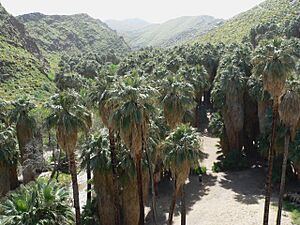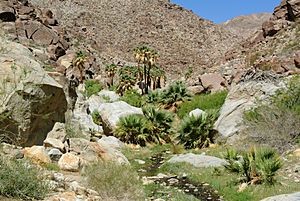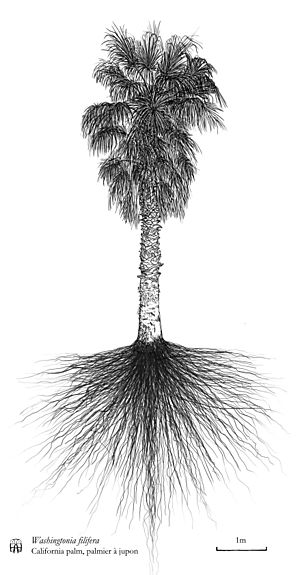Desert fan palm facts for kids
Quick facts for kids Desert fan palm |
|
|---|---|
 |
|
| Washingtonia filifera in native grove near Twentynine Palms, California | |
| Conservation status | |
| Scientific classification | |
| Genus: |
Washingtonia
|
| Species: |
filifera
|
 |
|
| Natural range | |
| Synonyms | |
|
|
The Washingtonia filifera, also known as the desert fan palm or California fan palm, is a type of flowering plant. It belongs to the palm family called Arecaceae. This palm tree grows naturally in the far southwestern United States and Baja California in Mexico.
These trees can grow very tall, usually about 15 to 20 meters (50 to 65 feet) high. They can also spread out 3 to 6 meters (10 to 20 feet) wide. The California fan palm is an evergreen plant, meaning it stays green all year. It has a strong, straight trunk and waxy, fan-shaped leaves.


Contents
- What is the California Fan Palm Called?
- Where Do California Fan Palms Grow?
- What Does the California Fan Palm Look Like?
- How Do California Fan Palms Live in Nature?
- How Have People Used California Fan Palms?
- Where Can You See California Fan Palms?
- How Are California Fan Palms Grown?
- Images for kids
- See also
What is the California Fan Palm Called?
This palm tree has a few common names. People often call it the California fan palm or the petticoat palm. The scientific name filifera means "thread-bearing." This refers to the long, white threads found on its leaves.
Where Do California Fan Palms Grow?
The California fan palm is the only palm tree that grows naturally in the western United States. It is also one of the tallest native palms in the country. Only the Cuban or Florida royal palm can grow taller.
You can find these palms mainly in desert areas where there are springs or streams. These places are called oases. They are common in the Colorado Desert and some parts of the Mojave Desert. They also grow near rivers in the Sonoran Desert, like along the Gila River in Yuma, Arizona. You can also find them in parts of Maricopa County, Pima County, and Mohave County in Arizona. Some isolated groups are in Clark County, Nevada.
This palm has also started growing in new places. It is now found in warm springs near Death Valley and in the northwest of Sonora, Mexico. It has also spread to South and Southeast Texas, Florida, Hawaii, the U.S. Virgin Islands, and Australia.
What Does the California Fan Palm Look Like?
Washingtonia filifera can grow up to 18 meters (60 feet) tall. In perfect conditions, it can even reach 25 meters (82 feet). Besides California fan palm, it is also known as the desert fan palm, American cotton palm, and Arizona fan palm.
The leaves, called fronds, can be up to 4 meters (13 feet) long. Each frond has a stem, called a petiole, which is up to 2 meters (6.5 feet) long. From this stem, fan-shaped leaflets spread out, measuring 1.5 to 2 meters (5 to 6.5 feet) long. These leaflets have long, white, thread-like fibers. The petioles are green with yellow edges.
The trunk of the palm is gray and tan, and its leaves are gray-green. When the fronds die, they stay attached to the tree. They hang down and form a thick "skirt" around the trunk. This skirt creates a safe, small home for many birds and insects. California fan palms usually live for 80 to 250 years or even longer.
How Do California Fan Palms Live in Nature?
Desert fan palms are important homes for many animals. These include the giant palm-boring beetle, western yellow bat, and hooded oriole. Hooded orioles use these trees for food and to build their nests. Many different insects visit the palm's flowers that appear in late spring.
Historically, natural oases were often found near hot springs. The water from these springs helped the palms grow. The environment in these oases may have protected the palms from colder weather changes over time. This is why these palms are found in separate groups, called relict groves. The trees in these groves are very similar genetically, meaning they haven't changed much over time.
How Do Fan Palms Survive Fires?
Fan palm oases have often experienced fires, both natural and caused by humans. Fires usually do not kill the fan palm, but they can still cause damage.
The trunk of the fan palm is very strong against fire. Most of the time, only the outer layers of the trunk burn. After these layers burn off, the remaining surface becomes charred. This charring makes the trunk even stronger against future fires. More fires can char the trunk further, increasing its fire resistance.
The fronds of the palm are the most likely part to burn. If too many dead fronds build up around the trunk, they can create a "skirt" that is very dangerous in a crown fire. A lot of dead fronds could provide enough fuel to burn through the trunk and kill the tree. However, if a palm survives a fire that burns its fronds, new fronds will grow back. This makes the tree less likely to catch fire again for a while.
Unless conditions are very extreme, fires can actually be good for fan palms. Fires help the palms reproduce by releasing young plants. They also clear away other plants that might be growing too close. Fires can also help palms save water. By burning away some of their leaves and parts of their trunks, the tree has less surface area. This means less water evaporates or is lost through the leaves.
What Are the Threats to California Fan Palms?
Animals that graze, like cattle, can harm young palm plants. They might step on them or eat the growing tip of the plant. This could have limited where palms could grow in the past.
The palm boring beetle (Dinapate wrightii) can chew through the trunks of these and other palm trees. If many beetles infest a tree, they can eventually kill it. However, W. filifera seems to be resistant to the red palm weevil (Rhynchophorus ferrugineus). This palm produces special compounds that are deadly to the weevil's larvae.
Currently, the number of desert fan palms is growing, and they are spreading to new areas. This might be due to global warming or the removal of too many wild horses.
How Have People Used California Fan Palms?
The sweet fruit of the fan palm can be eaten. Native Americans ate the fruit raw, cooked it, or ground it into flour to make cakes. The Cahuilla and other tribes used the leaves to make sandals, roof coverings, and baskets. They used the stems to make cooking tools. The Moapa band of Paiutes and other Southern Paiutes have stories about using the palm's seeds, fruit, or leaves for different purposes, including as food when other food was scarce. The bud of the palm, known as a heart of palm, has also been eaten.
Where Can You See California Fan Palms?
Joshua Tree National Park in the Mojave Desert protects healthy areas where these palms grow near water. You can also find them where water comes up through the San Andreas Fault. In the central Coachella Valley, the Indio Hills Palms State Reserve and the nearby Coachella Valley Preserve protect other large oases. The Santa Rosa and San Jacinto Mountains National Monument and Anza-Borrego Desert State Park also have many different W. filifera canyon oasis habitats.
How Are California Fan Palms Grown?
Washingtonia filifera is often grown as an ornamental tree in gardens and parks. It is one of the toughest palms in its group, able to survive in USDA hardiness zone 8. It can handle short periods of cold temperatures, around -10°C (14°F), with only minor damage. Established plants have even survived brief periods as cold as -12°C (10°F), though their leaves might be severely damaged. These plants grow best in climates like the Mediterranean, but they can also be found in humid subtropical areas like eastern Australia and the southeastern USA. This palm has received the Royal Horticultural Society's Award of Garden Merit.
Images for kids
-
Washingtonia filifera in native grove near Twentynine Palms, California
-
W. filifera in Palm Canyon, Santa Rosa and San Jacinto Mountains National Monument
-
W. filifera trees and fronds in Anza-Borrego Desert State Park
See also
 In Spanish: Washingtonia de California para niños
In Spanish: Washingtonia de California para niños









